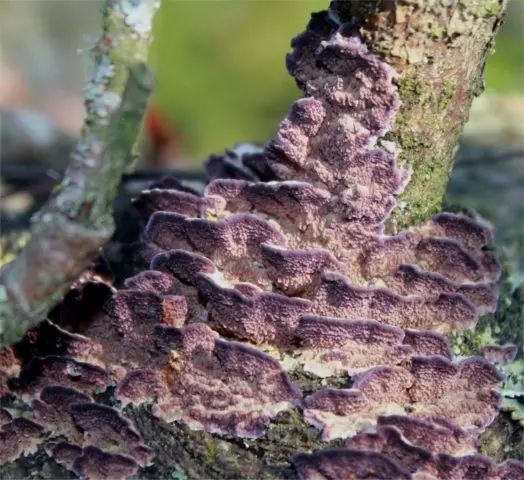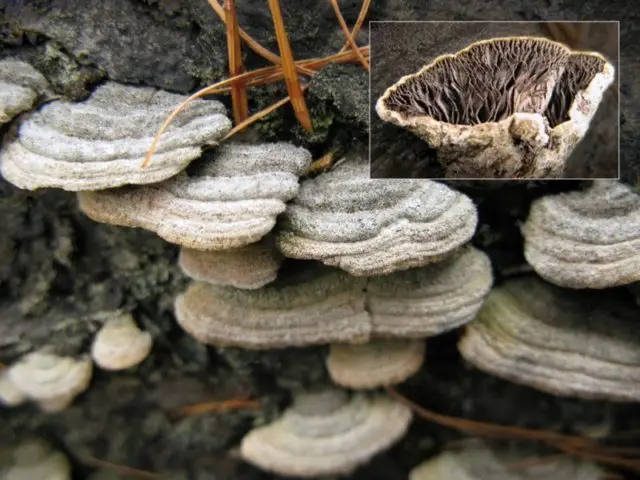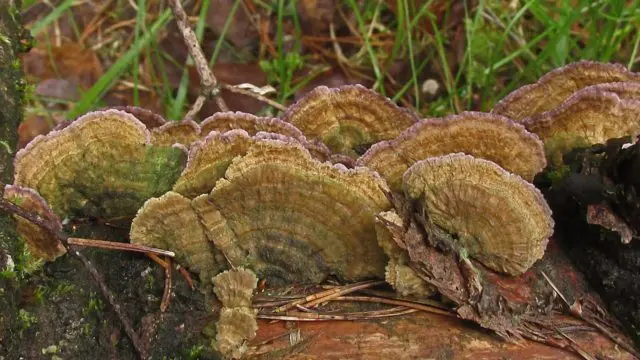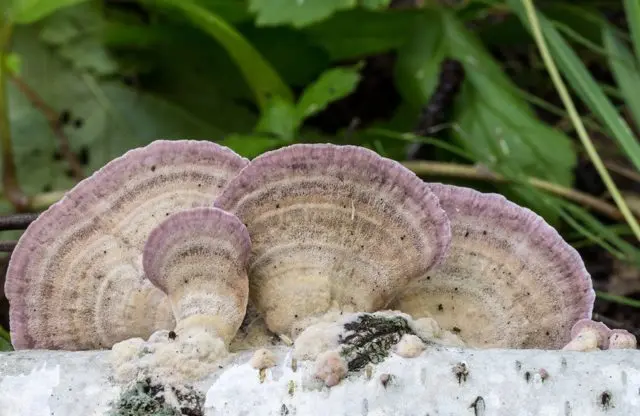Contents
Spruce Trihaptum is an inedible member of the Polypore family. Grows on moist, dead, fallen coniferous wood. Destroying a tree, the fungus thereby cleanses the forest of dead wood, turning it into dust and enriching the soil with nutrients.
What does Trihaptum spruce look like?
The fruiting body is formed by a flat cap with bent edges. It is attached to the wood with a side surface. The mushroom has a semicircular or fan-shaped shape. The velvety surface is painted in gray tones with purple edges. In humid weather, due to the accumulation of algae, the color changes to a light olive. With age, the fruiting body becomes discolored, and the edges are tucked inward.
The bottom layer is painted in a soft purple color, as it grows, it becomes dark purple. The flesh is whitish, rubbery, hard, with mechanical damage the color does not change. Trihaptum spruce reproduces by microscopic cylindrical spores, which are located in a snow-white powder.

The fungus grows on dry spruce wood
Where and how to grow
Trihaptum spruce prefers to grow on rotten, dry coniferous wood in Northern and Central Our Country, Siberia and the Urals. It grows everywhere, forming parasitic growths on the tree, which lead to the appearance of brown rot. The fungus harms forestry, destroying harvested wood and building materials. But, despite this, this representative is a forest orderly. Destroying and turning rotten wood into dust, it enriches the soil with humus and makes it more fertile.
Trihaptum spruce bears fruit from spring to late autumn. The development of the fruiting body begins with the appearance of a brown or yellowish spot. Further, light brown blotches of an oblong shape appear at this place. After 30-40 days, the inclusions are filled with a whitish substance, forming voids.
In the place of active growth of the fruiting body, the destruction of the tree occurs, which is accompanied by abundant resination. The fungus continues its development until the complete destruction of the wood.
Is the mushroom edible or not?
Spruce Trihaptum is an inedible forest dweller. Due to its hard, rubbery pulp and lack of taste and smell, it is not used in cooking.
Twins and their differences
Spruce Trihaptum, like any representative of the mushroom kingdom, has similar counterparts. Such as:
- Larch – an inedible species, grows in the taiga, prefers to settle on rotten, dry coniferous trees and stumps. The fruit body is prostrate, the hat, 7 cm in diameter, has the shape of a shell. The grayish surface has a silky, smooth skin. Most often grows as an annual plant, but biennial specimens are also found.

Due to the rubber pulp, the species is not used in cooking.
- Brown purple – inedible annual copy. It grows on dead, damp wood of coniferous forests. When infected, it causes white rot. The fruit body is located in single specimens or form tiled families. The surface is velvety, painted in light lilac color with brown uneven edges. In wet weather it is covered with algae. The flesh is bright purple, becoming yellow-brown as it dries. Fruiting from May to November.

The mushroom is inedible, but due to the beautiful surface it is suitable for a photo shoot
- Double – inedible forest dweller. It grows as a saprophyte on stumps and fallen deciduous trees. The species is distributed throughout Our Country, growing from May to November. The mushroom appears in tiled groups, the hat is 6 cm in diameter and has a fan-shaped shape. The surface is smooth, velvety, light gray, coffee or ocher. In dry weather, the hat becomes discolored, in wet weather it turns olive. The pulp is hard, rubbery, whitish.

The mushroom has a beautiful shell-shaped surface.
Conclusion
Trihaptum spruce prefers to grow on dead coniferous wood, causing brown rot on it. This type causes great damage to building material, if the storage rules are not followed, it quickly collapses and becomes unusable for construction. It grows from May to November, because of the hard, tasteless pulp, it is not used for cooking.












